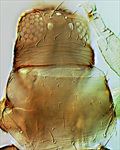
ajugae head & pronotum

ajugae tergites VII-X

bicolor sternites IV-V

bicolor abdomenVII-X

strobilus mouth cone

strobilus tergite X variation
[Cui, Xi & Wang, 2017]
Generic diagnosis
Female macropterous. Head wider than long, mouth-cone often elongate; maxillary palps 3-segmented; eyes with six pigmented facets; ocellar setae I present, setae III moderately large; four pairs of postocular setae in transverse row. Antennae 8-segmented, segment I without paired dorso-apical setae, III and IV with sense-cones forked, III–VI with some microtrichial rows on both surfaces. Pronotum with one pair of posteroangular setae. Mesonotum with median pair of setae far from posterior margin; campaniform sensilla present. Metanotum reticulate; median pair of setae far from anterior margin; campaniform sensilla present. Fore wing first vein with setal row irregularly spaced, second vein with many irregular spaced setae; clavus with five veinal and one discal setae; posteromarginal fringe cilia wavy. Prosternal ferna weakly divided medially; basantra membranous, without setae; prospinasternum broad and transverse. Mesosternum with sternopleural sutures reaching anterior margin; endofurca with spinula. Metasternal endofurca without spinula. Tarsi 2-segmented; fore tibiae often with tubercles at inner apex and stout setae. Tergites without ctenidia or craspeda; VIII without posteromarginal comb; IX with two pairs of campaniform sensilla, MD setae small; X with median split distally. Sternites with or without discal setae; sternites sometimes with one or more pore plates; VII with S1 setae in front of posterior margin; laterotergites without discal setae.
Male often with one pore plate on III–VI.
Biological data
Several species in this genus are recorded as breeding only within the male cones of species in the genera Pinus [Pinaceae] and Juniperus [Cupressaceae], although some European species are recorded from leaves of Quercus [Fagaceae] and Fraxinus [Oleaceae]. In contrast, one species in Australia breeds in the flowers of Normanbyia [Palmae], and another member of the genus is known to breed on the leaves of Cannabis [Cannabidaceae].
Distribution data
Species placed in the genus Oxythrips are recorded widely around the world.
Nomenclatural data
Oxythrips Uzel, 1895: 133. Type species Oxythrips ajugae Uzel, 1895, by subsequent designation, Hood, 1916: 37.
Chilothrips Hood, 1916: 119. Type species Chilothrips pini Hood, 1916, by monotypy. Synonymised by Zhang et al. 2018: 376
With the transfer of seven species from Chilothrips resulting from the synonymy indicated above, there are now about 45 species from around the world listed in this genus (ThripsWiki, 2020), of which four are recorded from China:
hangzhouensis (Hu & Feng, 2015: 251). (Chilothrips)
jiuxiensis (Mirab-balou Chen & Tong, 2012: 725). (Chilothrips)
strobilus (Tong & Zhang, 1994: 29). (Chilothrips)
ulmifoliorum (Haliday, 1836: 447). (Thrips)
.
Relationship data
Thripidae sub-family Thripinae: this is a diverse group involving more than 230 genera. Oxythrips is considered to be one of the 40 genera in the Anaphothrips complex, in which most species have no long setae on the pronotum (Masumoto & Okajima, 2017). Some of the species originally in the genus Chilothrips have abdominal tergite X unusually elongate, but this condition also occurs in the European species Oxythrips bicolor, and it is known to be variable in Oxythrips strobilus from China (Cui et al., 2017).
References
Cui YZ, Xi JH & Wang J (2017) Female polymorphism in Chilothrips strobilus (Thysanoptera: Thripidae), with the first description of the male. Zootaxa 4358 (1): 193–196.
Masumoto M & Okajima S (2017) Anaphothrips genus-group: key to world genera, with two new species and three new records from Japan (Thysanoptera, Thripidae). Zootaxa 4272 (2): 201–220.
ThripsWiki (2020). ThripsWiki - providing information on the World's thrips. <http://thrips.info/wiki/Main_Page>
Zhang SM, Wang ZH, Li YJ & Mound LA (2018) One new species, two generic synonyms and eight new records of Thripidae from China (Thysanoptera). Zootaxa 4418 (4): 370–378.